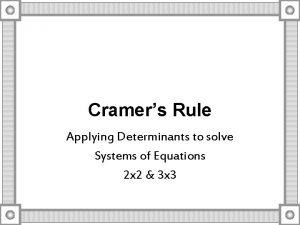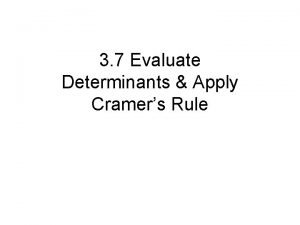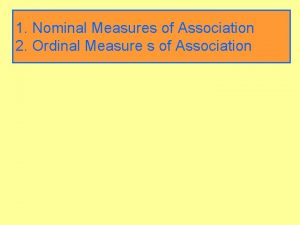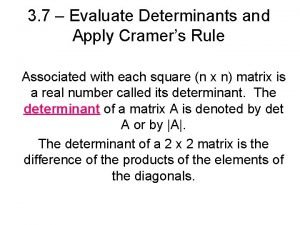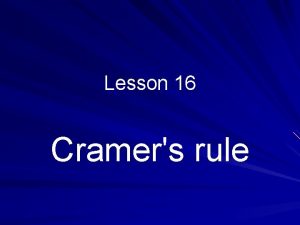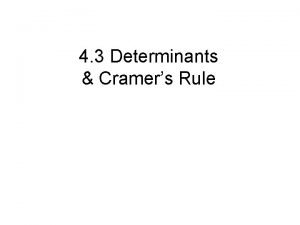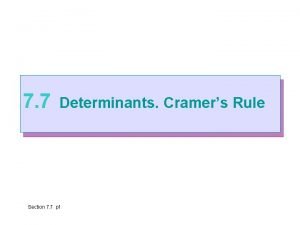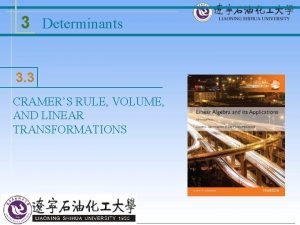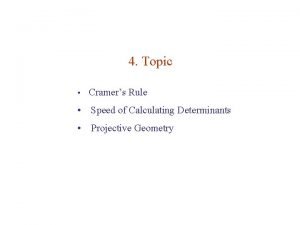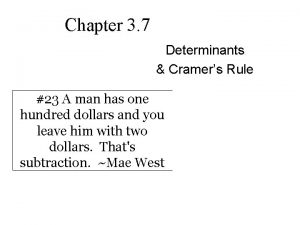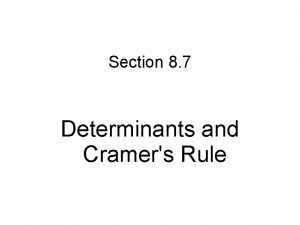3 7 Evaluate Determinants Apply Cramers Rule Associated











- Slides: 11

3. 7 Evaluate Determinants & Apply Cramer’s Rule

Associated with each square matrix is a real number called it’s determinant. We write The Determinant of matrix A as det A or |A|

Here’s how to find the determinant of a square 2 x 2 matrix: 40 (2 Multiply nd ) Multiply 24 (1 ) Now subtract these two numbers. st 24 (1 ) st - 40 (2 nd ) = -16 is the determinant of this matrix

In General

Determinant of a 3 x 3 Matrix (gec +hfa +idb) a b d g e h (aei+bfg +cdh) Now Subtract the 2 nd set products from the 1 st. (aei + bfg + cdh) - (gec + hfa + idb)

Compute the Determinant of this 3 x 3 Matrix (0 +4 2 -1 -2 0 1 (0+ -1 +8) 2 -12) Now Subtract the 2 nd set products from the 1 st. (-13) - (12) =-25

You can use a determinant to find the Area of a Triangle (a, b) The Area of a triangle with verticies (a, b), (c, d) and (e, f) is given by: (e, f) (c, d) Where the plus or minus sign indicates that the appropriate sign should be chosen to give a positive value answer for the Area.

You can use determinants to solve a system of equations. The method is called Cramer’ rule and named after the Swiss mathematician Gabriel Cramer (17041752). The method uses the coefficients of the linear system in a clever way. ax + by = e In general the solution to the system x= where e b f d a b c d is (x, y) cx + dy = f and a b c d =0 a e y= c f a b c d If we let A be the coefficient matrix of the linear system, notice this is just det A.

Use Cramer’s Rule to solve this system: ax + by = e cx + dy = f 4 x + 2 y = 10 5 x + 1 y = 17 x= y= e b 10 2 f d 17 1 a b c d x= 4 2 5 1 a e 4 10 c f 5 17 a b 4 2 c d 5 1 y= = (10)(1) –(17)(2) (4)(1) –(5)(2) (4)(17) –(5)(10) = (4)(1) –(5)(2) = = 10 - 34 4 - 10 68 - 50 4 - 10 = -24 =4 -6 = 18 = -3 -6 The system has a unique solution at (4, -3)

Solve the following system of equations using Cramer’s Rule: ax + by = e cx + dy = f 6 x + 4 y = 10 3 x + 2 y = 5 x= e b 10 4 f d 5 2 a b c d x= 6 4 3 2 = (10)(2) –(5)(4) (6)(2) –(3)(4) = 20 - 20 0 = 0 12 - 12 Since, the determinant from the denominator is zero, and division by zero is not defined: THIS SYSTEM DOES NOT HAVE A UNIQUE SOLUTION and Cramer’s Rule can’t be used.

Cramer’ Rule can be use to solve a 3 x 3 system. Let A be the coefficient matrix of this linear system: If det A is not 0, then the system has exactly one solution. The solution is:
